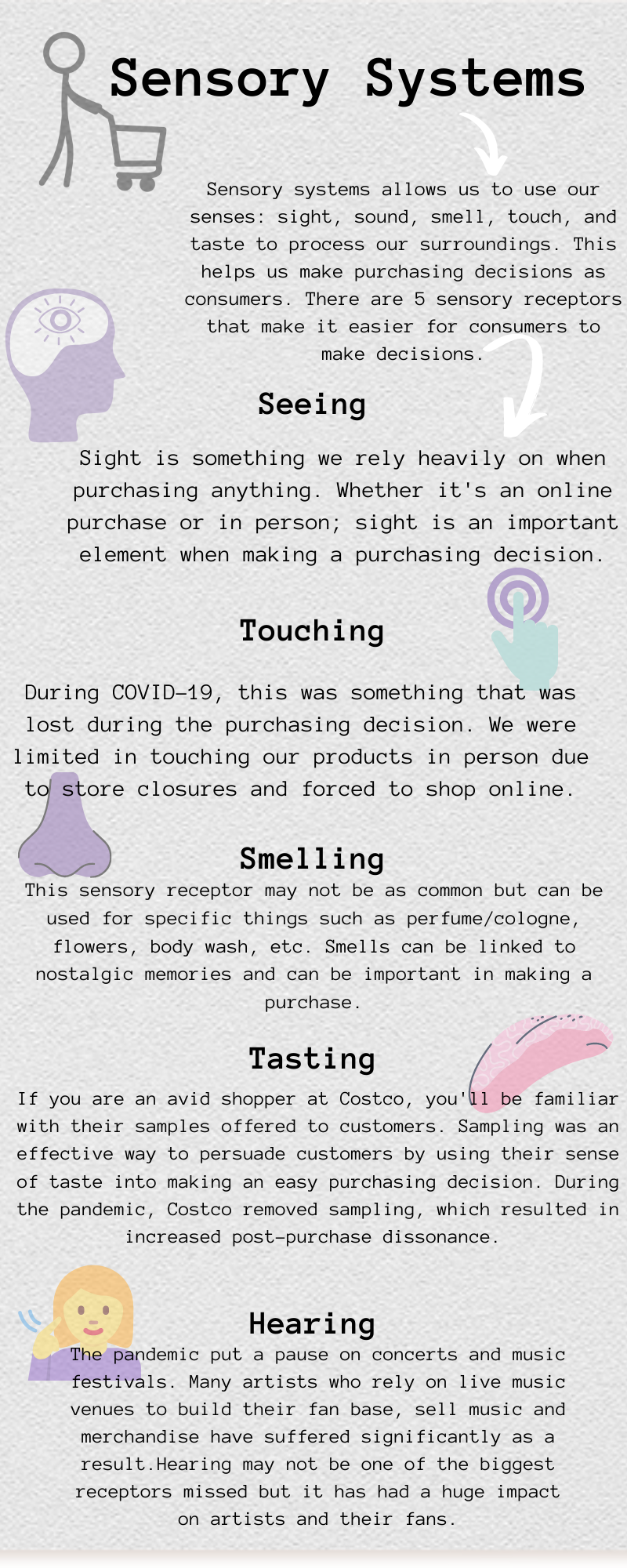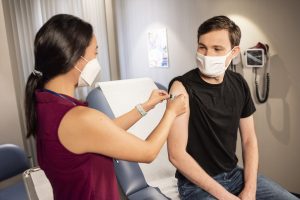A Pandemic Year in Review from the Consumer Perspective
Consumers all around the world have had to adapt their purchase habits and behaviours during the pandemic. Most of us have come to rely on the internet to make purchases previously done in person. Societal norms have also changed: from commuting to work, to working from home; from buying groceries in store to having them delivered; from going shopping in a mall to ordering online; and from going out to dinner with friends to socializing at a distance over Zoom.
We are going to be looking at the different concepts that consumers have come across during the pandemic along with the changes we have had to make. We will also be looking at the challenges we have faced during the pandemic while making a purchasing decision.
Sensory Systems

As a consumer in 2020… what has changed?
As consumers in 2020, everyone has been forced to change their habits and behaviors. Some of us have become detached to the things that we used to value: for example, prior to the pandemic I was going to the nail salon every two weeks to get a pedicure and manicure. Since the first lockdown measures I have not gone to the salon. Even now, with the salons all fully opened, I realized that I no longer had the desire to go as frequently as I used too. In this way I have become more detached from some consumer experiences and seen a shift and what I felt were once needs in my life.
Non-Conformity

The anti-mask and anti-vaccine communities have become very vocal since the start of the pandemic. Members of these groups have created communities to protect against the public health orders and mandates, which have informed new social norms. These individuals exist the typical traits of non-conformists: people who fail to abide the by the laws and social norms recognized by most people.
Anti-Brand Community
Just as individuals have had to adapt to new public health orders and guidelines from the government, so have retailers and brands. Those brands who have shown support for masking (even when it’s not been mandated) and vaccinations have received backlash from the small community of nonconformists. This specific kind of brand opposition by members of a group who share the same opinions regardless of where they are in the world is known as anti-brand community. Most anti-brand communities protest by not purchasing the brands products or services.
Observational Learning
Observational learning is a “type of learning that occurs when people observe behaviour, responses, and actions of others” (Niosi n.d.). When taking a deeper look into observational learning, we find that we are modelling other’s behaviours. Who do we choose to model? Someone who we admire and look up to. Which leads us into social models.

Throughout the pandemic, key individuals, also known as social models, have successfully promoted mask wearing and vaccines. Social models may be celebrities, athletes, musicians, or any other influential person that others assign some informal power too. They often have a large platform or following and are well known even beyond their most loyal followers. Some examples of social models who actively inform the public to follow health regulations are: Britney Spears, Ariana Grande, Ryan Reynolds, Miley Cyrus, Julia Roberts, Patrick Mahomes, and many more.
The Consumer Decision Making Process

Cognitive Dissonance
As a consumer, I have experienced my fair share of cognitive dissonance over the past year and a half. Because I haven’t been able to go into stores to see items in person, I’ve had to rely on alternative techniques to make decisions, such as reading online reviews by others consumers. Not too long ago I was making a complex consumer decision – what kind of desk to buy for my Home Office. I searched multiple furniture sites; read several consumer product reviews; and then finally decided on a “sit and stand desk” from a brand that I am familiar with. Based on my previous purchasing experience, I have always trusted this brand.
After two weeks my new desk finally arrived. When I opened the box the colour was a different shade than what it showed on the website although it was the correct colour code the shade on the website compared to the product itself was completely different.
The reviews that were left for the desk said it is quote perfect height and quote for someone who is 5’8. Being 5’6, I assumed this would still be a good fit for me which was the main incentive for making the purchase. When I set the desk up, it was still not high enough. Had I been able to make this purchase in person, I would have been able to see how high the desk actually was.
This online purchase filled me with regret and disappointment. I was unable to reconcile spending money on a product that didn’t meet my expectations and gave me so much dissatisfaction. This feeling of cognitive dissonance was resolved when I boxed up the desk and sent it back for a refund.
By Heena Bains (2021, August)
Media Attribution
- The image of the anti-mask and anti-vaccine symbols is by Heena Bains and is licensed under CC BY-NC-SA-4.0.
- The image of the person receiving a Covid19 vaccination is by CDC on Unsplash.
Text Attribution
- Niosi, A. (n.d.). Introduction to Consumer Behaviour is licensed under CC BY-NC-SA-4.0.
people who fail to abide the by the laws and social norms recognized by most people.
a type of learning that occurs when people observe behaviour, responses, and actions of others.

